Super Early Deadline
30 November 2025
Judging
Date
24 & 25 March 2026
Winners Announcement
22 April 2026
30 November 2025
24 & 25 March 2026
22 April 2026

Step into the world of luxury spirits and hospitality with Adam Hussein, Brand Ambassador for Johnnie Walker Blue Label. In a world where tradition meets innovation, Johnnie Walker, the world's leading Scotch Whisky brand, embarks on a captivating journey with a unique twist. Today, we dive into the creation of Johnnie Walker Blue Label Elusive Umami, an exceptional expression that explores the mysterious fifth taste in collaboration with the renowned culinary virtuoso, Chef Kei Kobayashi. Master Blender Emma Walker, Chef Kei, and their combined expertise have embarked on a flavor discovery expedition that has led to an exquisitely balanced Scotch whisky, deftly blending sweet and savory notes, inspired by the enigmatic flavor known as umami.
Of course. I believe my journey to have started in a bar in Melbourne called 18o6. It is a classic cocktail and whisky-focused cocktail bar located in the center of Melbourne CBD. When I joined, the team were people I admired – people I considered superstars. I won’t lie, it was intimidating at first and I wanted to prove myself to my peers to show that I was a good fit for the team.

Image: Adam Hussein chatting with his guest at Johnnie Walker Blue Label.
During my year’s tenure here, I learned that the guest, and service, are the key priorities within our industry and that egos need to be left at the door – bartending isn’t about you.
After this, I headed to New Zealand and when here I was messaged by a friend of mine stating that Artesian, London, was looking for a new team member. This was the bar I had been drawn to for some time due to the work they had done and the quality of the team they had. I applied nonetheless as I always tell people to throw their hats in the ring for opportunities, even if they don’t think they could land the job. It’s always better that people are talking about you rather than not.
I left New Zealand several months later and when I landed back in the UK, I reached out to the then bar manager of the Artesian, Anna Sebastian, who invited me for an introductory chat – a sense check if you will. Shortly after this, I departed back to Belfast (where I’m from) and to my surprise was offered and second and third round interview with the hotel manager and Human Resources team respectively.
The following week I was offered the role in the Artesian and I was completely blown away, what a time that was. I moved to London three weeks later and the rest they say, is history.
Within my time at the venue, we achieved a spot in the World’s 50 Best Bars again, hosted international takeovers, showcased a world-class 2 flavor menu, and began work on a menu that would have shaken up the global cocktail scene.
Here, I made connections with my team and guests I could have never fathomed possible, made drinks I never imagined, and learned information that now seems second nature but at the time was so alien to me. Understanding five-star luxury was a blessing as it translates into many different facets of life and even though my job was lost to COVID-19 I can proudly say that I have been there and done that – my time at the Artesian was truly priceless.
Due to COVID-19, like many, I decided to return back to Ireland and figure out my next steps both personally and professionally – this is when I decided to throw myself fully into my next project, my book, ‘Rise Of The Bartender’.
There were rumors of a new hotel opening in London in the coming months so I reached out to several people to confirm its certainty. The next thing I knew I was applying for a bartending role at The NoMad Hotel, a now staple in the London cocktail scene. There were several delays due to the ongoing pandemic but eventually, the hotel opened in early 2021 and we had a superstar bar team that felt like we could take on the world.
At the NoMad we all discovered a new style, a new methodology to not just bartending, but hospitality in general. We had a group of leaders at the helm that stemmed from places like 11 Madison Park, New York, and had built what NoMad would become from the ground up.
Major takeaways were:
Every detail matters
Slow down to speed up
The guest is the most important aspect of service
Be intentional
You get what you give
Here we threw the most outlandish parties in a fun, inviting, and hospitable way, showcased a number of people who have continued to grow from strength to strength and I personally was able to find what I truly loved about this industry again – hosting and education.
This doesn’t even scratch the surface of what I uncovered at NoMad - I truly grew as a person here and my journey from bartender to head bartender to food & beverage supervisor was one of the longest and most rewarding journeys I have had in my career.
It was during the latter part of my time here that I was approached via social media by the reserve team within Diageo and exposed to several upcoming opportunities that the team had – one being my eventual new role as the Johnnie Walker Blue Label Brand Ambassador. I wrapped up my time in December 2022 and took some time to myself before starting at Diageo in January 2023.
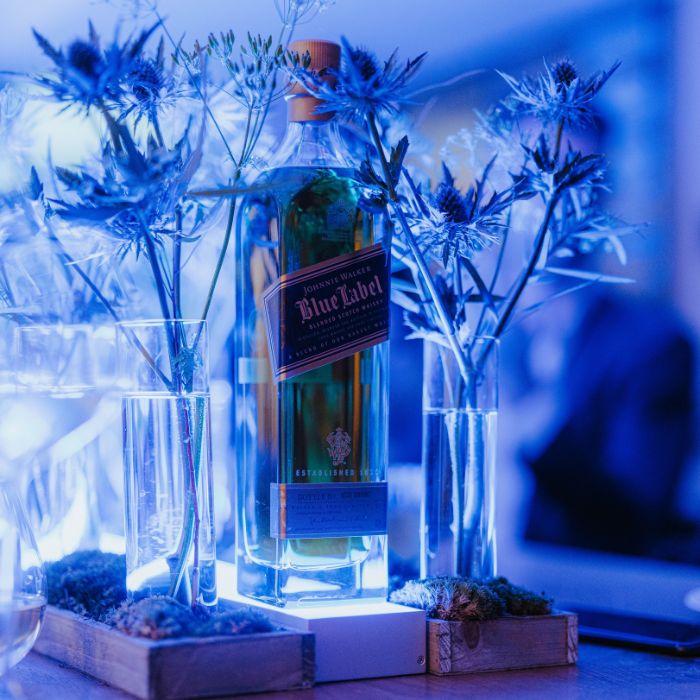
Three decades ago, it would have been very difficult to find spirits considered ‘luxurious’ other than perhaps a few Cognacs, wines, or Champagnes.
The world was yet to discover what luxury whisky meant, but Johnnie Walker dared to be a pioneer; taking a bold step to blend some of the rarest whiskies in the world and create one with an incredible depth of flavor.
The result was one of the finest creations from our former master blender Jim Beveridge. Jim Beveridge would describe Johnnie Walker Blue Label as a ‘rolling wave’ of flavor:
An initial swell of intoxicating aromas and bright notes on the tongue, followed by a warming of the palate and a burst of new flavors, and then a long, complex finish as the wave subsides.
We’ve identified eight ‘key flavors’ that are the backbone of Blue Label – Key flavors are - cedar, sandalwood, cacao, hazelnut, orange, sherry, rose, and apple.
By taking whiskies of varying ages - some very mature, some more vibrant, from all four corners and distilleries in Scotland, at the peak of their power, the apex of their maturation, Jim personified how great a blended whisky could be.
It is the task of our blenders to choose and then combine these different whiskies into balanced blends – and nowhere in the Johnnie Walker range are the standards for a whisky’s inclusion higher than in Blue Label. Crafted from some of the oldest, rarest, and most exceptional whiskies in our reserves, only one cask out of every 10,000 makes it into a bottle of Johnnie Walker Blue Label.
When our twelve-strong blending team, sets out to produce any Johnnie Walker expression, led by current-day Master Blender, Dr Emma Walker, they choose their ingredients from an unparalleled reserve of over 10 million casks. These ‘malt’ and ‘grain’ whiskies from over 80 distilleries scattered across the ‘four corners’ of Scotland, all carry the unique character of the distillery where they were first made.
One of the casks might represent a cask of tropical ‘Clynelish’; another might be Speyside’s rich, robust Mortlach, or even the Lowland’s Cameronbridge grain whisky its signature creamy vanilla note. It is the task of our blenders to choose and then combine these different whiskies into balanced blends – and nowhere in the Johnnie Walker range are the standards for a whisky’s inclusion higher than in Blue Label. Crafted from some of the oldest, rarest, and most exceptional whiskies in our reserves, only one cask out of every 10,000 makes it into a bottle of Johnnie Walker Blue Label.
I like to enjoy Johnnie Walker Blue Label as an ode to the blenders initially – so neat with some ice is perfect for me. However, there are certainly times I love this liquid in a cocktail, the texture, and flavor really amplify your drinking experience.
This is a great question and I truly wish I had one singular answer for this, but when you investigate so many hundreds of cocktails you honestly uncover more than you would expect.
I believe the best answer I can give is that there is a plethora of stories that are in circulation, that I believed at one time also, that simply aren’t true. There is a constantly changing world in hospitality and stories get passed around and changed so frequently – this was one of the major areas I wanted to tackle when releasing this book. Information is a wonderful thing.
If I had to pick something to entice people it would be just how many variations of a single drink there can be by swapping out one ingredient – it truly is mind-blowing.
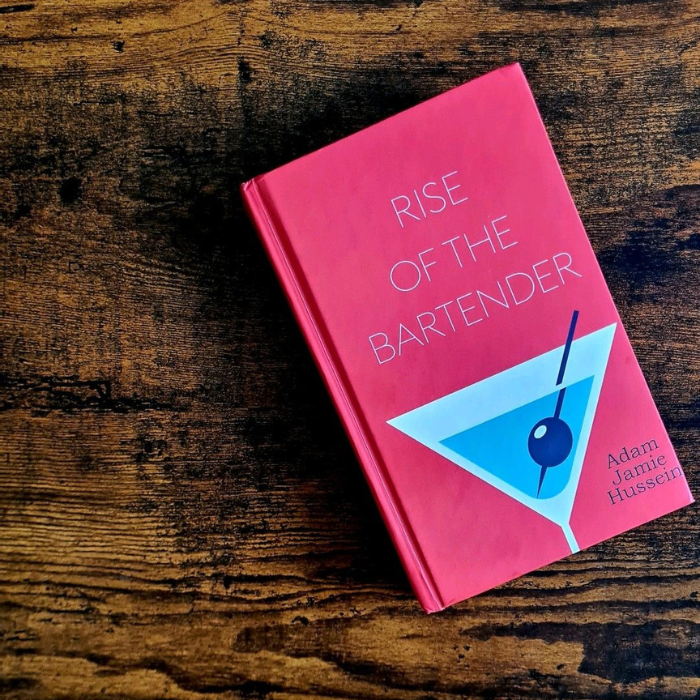
PENICILLIN
50ml Johnnie Walker Black Label
20ml Lemon Juice
12.5ml Honey Syrup
12.5ml Ginger Syrup
7.5ml Lagavulin 16 Float
METHOD
Shaken and strained into a rock glass over ice
Garnished with a lemon wedge, candied ginger, and peat whiskey float
Created in 2005 at Milk and Honey by the one and only Sam Ross, the architect of many classic drinks and cocktail culture in New York.
Ross himself states that one day there was a delivery with a newly released line of Compass Box whiskey and was playing around on a riff of a ‘Gold Rush’ (bourbon, honey, and lemon juice), which was created by T. J. Siegal, another involved with Milk and Honey.
Scotch was a replacement for bourbon and Ross added ginger for a spice aspect to the cocktail. The final addition was a float of Peat Monster scotch, a heavily smoked whiskey that he thought would contribute a complementary aroma. Ross wasn’t convinced, but it was a huge success:
“I was happy with it but I didn’t overthink it.”
Sam Ross traveled to Los Angeles in 2007 as a consultant and introduced several bartenders to the cocktail, and many others.
“They went on to do their own programs at different places ... That’s how the Penicillin spread hard throughout the West Coast.”
The drink is aptly named after Nobel Laureate Alexander Fleming, who discovered Penicillin and its therapeutic benefits and was Scottish.
When you think of it, how it took until 2005 to combine, lemon, honey, ginger, and whiskey into a cocktail is truly mind-blowing. Seems like such an obvious combination to us nowadays.
NOTES:
• Swap the Scotch whiskey for gin and the Islay whiskey for a spritz of rosewater and you get a ‘Son of a Bee Sting’ cocktail.
REVOLVER
50ml Bourbon
15ml Mr. Black Coffee Liqueur
5ml Simple Syrup
Two dashes of Orange Bitters
METHOD
Stirred and strained into a coupe
Garnished with a flamed orange peel
Created by Jon Santer in 2004 at Bruno’s, San Francisco, but then popularised at Bourbon and Branch. This cocktail was likely aided by the coffee movement that swept the West Coast of the United States several years ago.
The cocktail’s name is a play on the spirit used, Bulleit bourbon. Rather than reaching for a bottle of sweet vermouth, Santer used coffee liqueur to compliment the spiced flavors from the heavy rye whiskey and add additional sweetness joined by naturally bitter coffee flavors. The flamed orange peel not only adds a theatrical essence but also contributes to highlighting the desirable flavours in the cocktail.
Jeffery Morgenthaler’s The Bar Book (2014) recalls the time he first uncovered the cocktail while in New York from a well-traveled patron. Couple this with the cocktail’s inclusion in Three Ingredient Cocktails (2017) by Robert Simonson, you can see why this cocktail has been pushed to modern-classic status.
These should be at the cult-classic fandom level. They are excellent in structure and exceptional in flavor and can be an easy sidestep from other classic cocktails built in the same vein. I truly believe they need more attention.
As much as I would like to say I was involved in the process from the beginning, that would not be a factual statement. These decisions are debated and checked for many years before there is a starting point – so it is likely that this product has been discussed from far before I joined Diageo.

Image: Adam Hussein at the Johnnie Walker Blue Label Elusive Umami release in Paris.
The concept for the liquid was to create a limited-edition liquid that once it’s gone, it’s gone. It was about breaking down the walls of flavor between food and beverage to showcase that they are intertwined.
However, in the way you described, it is as such, a pioneering expression from a brand that has over 200 years of deep history. The concept of umami is one that we all share yet we all see it in a different way, and this was the same for our team of whisky makers – how do we characterize, and bottle, this elusive flavor? And thus, the journey began.
I agree with this statement, collaborating with a world-renowned chef was a unique approach in the world of whisky creation – but it is my hope that this action becomes more common practice within the drink’s creation scene.
It was a rigorous process, as anything in this vein would be, as selecting anyone to partner with on this journey would dictate the future direction of this release.
Chef Kei and his restaurant in Paris, Restaurant Kei, push the boundaries within the luxury gastronomy world and showcase classic flavors in an elevated way, and unique flavors in an approachable way.
Chef Kei brought his clear concept of what umami means to him specifically, and what it means in the wider world of elevated dining and Dr. Emma Walker brought the scientific understanding of how chemical compounds work together with the clear message of the brand.

Image: From left to right - Dr. Emma Walker and Chef Kei
This was a true fusion of art and science at its core.
Nose: Sweet and savory, fresh green & red apples, confectionary sweetness, hints of cashew nut, notes of salt brine, and savory accentuated without losing freshness. A scent of aromatic persistence.
Taste: Apple and white peach touch the senses first. Sweet, smooth, and long – mandarins, blood oranges, and red berries, the longer finish of sweet wood spice, a touch of smoked meat, warming salt and pepper with a long, sweet fruit finish.
Finish: The liquid has a long, sweet fruit finish of sweet wood spice.
The reason the liquid is called ‘elusive umami’ and not simply ‘umami’ is because it is wildly complex to place a singular identity as to what it actually is or means.
Also, there are not four basic flavors, but (at least) five: sweet, salty, sour, bitter, and umami.
In the New Yorker, Hannah Goldfield defines it as “that deep, dark, meaty intensity that distinguishes seared beef, soy sauce, ripe tomato, Parmesan cheese, anchovies, and mushrooms, among other things. It hits the back of your throat and leaves you craving more.” It is deliciousness — umami, she explains, roughly translates to “deliciousness” in Japanese — but it is not just any deliciousness. Umami is a specific type of deliciousness, the savory thread connecting mushrooms to ripe tomatoes.
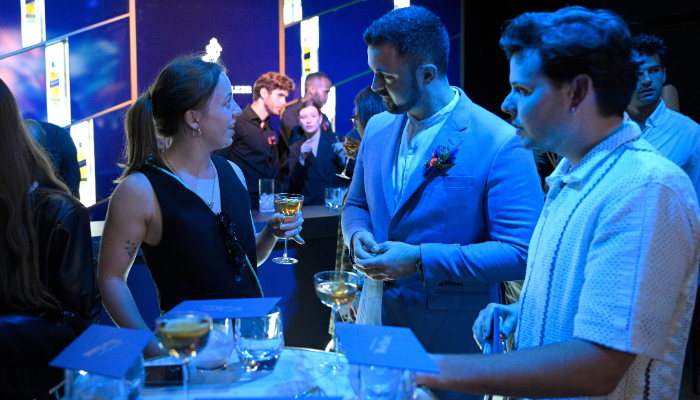
Food historian and scholar Ken Albala has experimented with making katsuobushi from scratch to understand the flavor better. “Umami is actually several different chemicals, often acting in concert,” he says. Arriving at the perfect balance of flavor molecules creates the mysterious umami taste.
Chef Kei invited Emma and George to chew a ripe cherry tomato 250 times in order to experience one dimension of umami – try it for yourself.
From my discussions with Emma Walker and the whisky makers, they shifted their view on cask selection. After talking with Chef Kei they began to look at casks of whisky-like ingredients used to create a spectacular dish. This outlook showed how whisky casks can utilised in a fresh way and combined to unlock elusive characteristics.
The challenges were discovering that some of the ingredients for this limited bottling needed to be very old as these older whiskies would show new flavors over time but would also have finite numbers available. Again, umami is such a difficult character to pinpoint that the combination of sweet, salty, savory, freshness, and smoke had to be in perfect harmony – a true challenge in itself.
Conversely, the rewards were discovering that even though you have done something for such a long period of time, there are always new ideas that can come from collaboration – and thus it is worth the challenge moving forward.
The sturgeon caviar pairing is an incredibly delectable pairing. Not only is the flavor of the caviar umami in itself – sweet, creamy, salty, and buttery – but it is also the mouthfeel and texture element that is highly elevated through this collaboration.
My perfect serve is a glass of iced water, a small spoon of sturgeon caviar, and Johnnie Walker Blue Label Elusive Umami neat. The caviar needs to be savored and fully immersed, along with the Elusive Umami that should be held on your palate for upwards of 11 seconds. The difference between having the liquid solo against having it with the caviar is highly noticeable.
I am excited for the future of pairing with this liquid; to try it with sushi, ramen, smoked meat, and cheeses.
Elusive Umami can be found in most luxury retailers and high-end spirits retailers. Venues such as Harvey Nichols, Selfridges, The Whisky Shop, and the Whisky Exchange.
You can also source it from The Bar at Home at Diageo 1HG in London.
There were some incredibly special events in both Paris and Edinburgh. We completely took over a luxury space in Paris within the Place Vendome (beside the Ritz hotel) which we turned into a fully immersive experience that showcased the concept of umami with the environments of earth, wind, and water.
The event in Edinburgh was hosted at Johnnie Walker Prince’s Street and was the second step in the global media and consumer launch for this innovative product. We hosted 100 of our closest customers over two days and immersed them in a world of blue. The liquid was solely available at Johnnie Walker Prince’s Street for the first two weeks of launch.
After these events, we held a launch in Singapore and New York – which looked sensational.
The desire for ease of access to information is certainly a trend that is happening right now. Consumers now live in a world where information is at their fingertips constantly and want to be able to verify their own biases. Producers, advocates, and ambassadors must be willing to share information freely and ensure that the consumer is satisfied. From working on-trade service I can say from experience that guests love it when you can distill their drink to digestible terms – this way they can make a more informed choice which subconsciously makes the drink taste better. The better equipped someone feels the better guest experience you can provide (which is the ultimate trend).

People are spending more but less frequently. Consumers recently have been spending more on overall experiences but are actively engaging in fewer outings. This is something I have noticed myself in the past 18 months. Consumers want more of an overall experience rather than simply what serve(s) is on offer to them at any venue; how did the experience make them feel, would they return, and was it worth more than what they paid for? People will always remember how you made them feel, not necessarily what they had to drink – and the best part is that we get to write the last chapter of their experience each time we engage as a brand or as a cocktail venue.
Premium cocktail venues tend to be leaning more into the field of gastronomy. Leveraging food along with, or within, cocktails – a great example of this is the New York venue Double Chicken Please (recently voted the world’s No.2 bar). This concept has floated around the cocktail world for a long time with techniques like fat-washing and infusions, but the idea of moving forward is how we continue to innovate and elevate forward.
Cocktail and food pairings have always existed but again it’s about how we utilize things like texture and flavour in new ways to showcase the fantastic liquid or serves that are on offer.
[[relatedPurchasesItems-63]]
Put simply, the agave trend is already here.
My number one piece of advice is, and always has been, to master the classics first. I’ve seen too many people try to run before they can walk and it generally follows the same path. If you look at any profession you will hear the same advice, master the basics and the rest will follow – it is rare that anything great comes to you quickly. By doing this you understand the basic DNA of cocktails that you can shift and play around with to create something new, then, add flavor agents to begin to manipulate this DNA.
Learn about different techniques from those who have mastered them. These techniques can range from infusions & fermentation to distillation & clarification. The point here that I want to convey to everyone is that there are no stupid questions. Everyone starts from somewhere and the best way to learn is to ask questions – get not only the how but the why also!
Understand that people within the hospitality industry want to help you. They started in the same place and want to continue to see the industry grow from strength to strength with new talent. Just remember that when people come to you as a newer entrant to the bar industry, be humble and give them the time that you got in the past – you never know they might just be the next big thing.
This event was a blending session that I held. Johnnie Walker has invested around £180million to renovate and regenerate 4 distilleries in each corner of Scotland. Each individual distillery has its own unique whisky brand and flavour profile that when combined create the Johnnie Walker blends that we all love to this day. These 4 Corners of Scotland are the homes of Glenkinchie, Cardhu, Caol Ila, and Clynelish.
We tasted these liquids coupled with Haig Club grain whisky, ultimately culminating in a tasting of Johnnie Walker Blue Label.
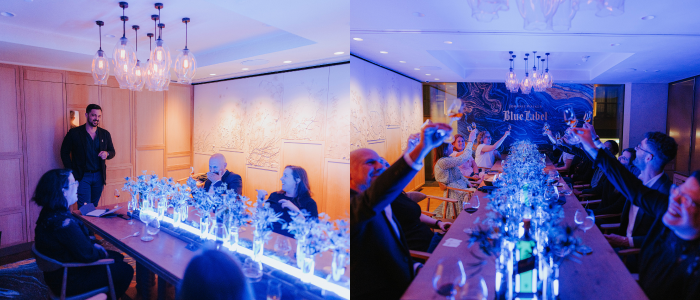
I hosted a tasting of these liquids and spoke about the history of the distillery and the region, then on the reverse of the tasting mats there was a recipe for a 200ml blend for their own whisky to talk home. If they preferred one style of whisky more than the rest, then we hand-blended a 200ml whisky individual to them.
This was to be a more tangible experience for people as most whisky experiences follow the same pattern, so I really wanted to elevate this consumer experience.
Sustainability – Environmental concerns are becoming more important. Premium spirit brands may focus on sustainable sourcing of ingredients, eco-friendly packaging, and reducing carbon footprint.
Limited edition and collectibles: Limited edition releases and collectible bottles create excitement and exclusivity around premium spirits. This drives desirability and over-brand awareness.
Tequila / Agave: I can only see this gathering more momentum the world over.
Tea in cocktails: I have seen the use of tea as a method of dilution or flavor manipulation in the recent month and I think it is here to stay. It is a clear-cut method of incorporating flavour and dilution in one ingredient within a cocktail which is a win-win in my books.
The spritz is here to stay! This style of cocktail has been making its way into the mainstream focus and is an absolute delight to see. A lighter, more accessible way to enjoy your favorite spirits at any point of the year. This also alludes to changing consumer habits as they are more conscious of what and how they are consuming alcohol, a void in which the spritz can fill.
Premiumization is still a core focus. Consumers prioritize certain qualities in a brand. Good value is still important but it's not about being cheap, it's about getting an experience that's worth the money they invest. They’re not necessarily looking for the cheapest option on the bar; they're looking for something they perceive as valuable. So, in summary, consumers still value quality and premium experiences, but they are adjusting the frequency and timing of their outings to match their preferences and changing lifestyles.
Flexible working driving consumer behaviors:
There has also been a significant shift in consumer behavior driven largely by the fact that many people are now working from home. This has created a unique opportunity in particular for localised outlets like pubs and local brands. These establishments have made a remarkable comeback in recent years, resonating with consumers who spend most of their workweek at home.
The rise in remote and hybrid working has noticeably impacted sales patterns. Traditionally, Saturdays have accounted for 28% of the total weekly value in the market. However, Fridays, Saturdays, Wednesdays, and Thursdays are losing their share to Sundays.
This trend has been particularly pronounced in London, where there has been a significant decline in Friday sales compared to other days. People seem to be more inclined to enjoy themselves on Sundays - perhaps because they don't have to worry about work the next day. A bit of a hangover might not seem like such a bad thing when you have the luxury of a commute-free Monday.
Experience led venues
Experience-led venues often become focal points in city centers, drawing people in for the entire day or night. These venues offer various experiences, ranging from golf and shuffleboard to escape rooms and arcades. And it's not just limited to city centers; town centers and suburban areas are also witnessing a surge in such venues. They provide a compelling reason for consumers to venture out, socialize with friends, and spend money.
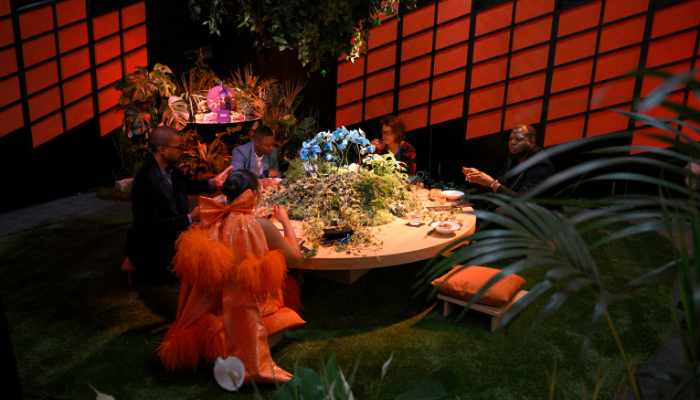
Experience, in its various forms, is becoming increasingly important for all types of outlets, including pubs and bars. Whether it's live music, beer or spirits tastings, quiz nights, or other interactive events, people are actively seeking reasons to step out. This presents a remarkable opportunity for hospitality establishment owners to engage in marketing campaigns that will attract patrons to their establishments for these unique experiences.
As the whisky world continues to evolve, Johnnie Walker's release of Blue Label Elusive Umami demonstrates their commitment to pushing the boundaries of what's possible in whisky. This limited-edition liquid is a fusion of gastronomy and craftsmanship, creating an immersive experience that ignites all the senses. From the intricate selection of casks to the mysterious allure of umami, this expression represents a new chapter in whisky appreciation, attracting a new generation of enthusiasts. Join us as we raise a glass to the captivating journey of Johnnie Walker and Chef Kei Kobayashi in capturing the elusive taste of umami and unlocking a unique sensory experience.
In conversation with Malvika Patel, Editor and VP, Beverage Trade Network
Show your spirits where it matters. Get your products tasted by top bartenders, buyers and experts at the London Competitions — enter now.